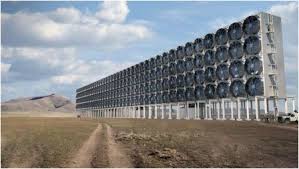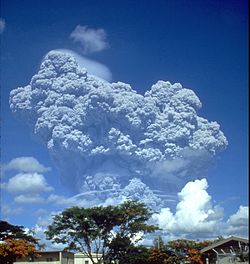If We Don’t Stop Global Warming, You’re Not Going to Like Plan B
Oct 10 2014If we don’t take immediate and concerted action to slash fossil fuel emissions, we face “high to very high risk of severe, widespread, and irreversible impacts globally” from climate change, according to a leaked draft of a report by the U.N. Intergovernmental Panel on Climate Change (IPCC).
But in this country, there is no possibility for the all-encompassing energy 
policy that is needed to confront the threat. The Obama administration has raised auto fuel efficiency standards and is moving to restrict power plant emissions, but Republicans and those Democrats who hail from coal-producing states call the plan a “war on coal” and will sue to keep them belching pollution. The American public is largely indifferent. Constant naysaying in the partisan media has persuaded 1 of 4 Americans that global warming is a hoax or of little concern, says an April Gallup poll; only 39% are “concerned believers”; the rest had mixed views.
But even those who disbelieve should spend a few moments to think about what will happen if they turn out to be wrong and nothing is done sufficient enough to reverse global warming. What sort of world will we live in when, too late, we need to take desperate measures?
Clusters of scientists around the globe are dealing with the question of what we would have to do. Expecting that mankind will go on heedlessly extracting and burning ever greater quantities of fossil fuels, they follow a different path from the usual climate scientist. Their fear is that the planet may tip beyond a point of no return and experience a climate emergency for which we had better have a Plan B. To that end most are exploring ways to affect the climate itself. The umbrella term for their hypothetical solutions is geo-engineering.
the search for solutionsOne camp favors capturing carbon dioxide. Increasing plant life is of course a well-known antidote, especially planting the more rapidly-growing genetically-modified trees developed by the lumber industry. But plant matter releases its CO2 when it dies, so we would only be borrowing time. There’s capture and burial of carbon dioxide by emitting industries, but industry can’t be counted on to adopt this costly technology.
![]() So one solution engineers propose is “direct air capture” that sets up
So one solution engineers propose is “direct air capture” that sets up 
arrays of fans to pull air through filters to capture CO2 for burial. A variant of this idea would use plastic mesh sheets to trap CO2 from the wind that would then be doused with sodium carbonate, yielding harmless baking soda.
![]() But few see these as adequate to the global task. An oft-mentioned method puts nature to work. It would fertilize vast stretches of the oceans with iron dust. Blooms of plankton algae would sprout to suck carbon dioxide from the air in order to grow by photosynthesis. When the algae dies, the assumption is that it would sink to the bottom rather than release its CO2 into the atmosphere. Done widely enough to make a difference, however, the worry is that it would change the chemical composition of the oceans with unknown consequences for marine ecosystems.
But few see these as adequate to the global task. An oft-mentioned method puts nature to work. It would fertilize vast stretches of the oceans with iron dust. Blooms of plankton algae would sprout to suck carbon dioxide from the air in order to grow by photosynthesis. When the algae dies, the assumption is that it would sink to the bottom rather than release its CO2 into the atmosphere. Done widely enough to make a difference, however, the worry is that it would change the chemical composition of the oceans with unknown consequences for marine ecosystems.
We endanger ecosystems now. In desperate times consequences will be ignored.
![]() Instead (or as well), what about increasing pollution in the atmosphere to block the sun’s rays from reaching Earth? This is probably the most
Instead (or as well), what about increasing pollution in the atmosphere to block the sun’s rays from reaching Earth? This is probably the most 
widely advanced solution. The trade off would be hazy days in place of sunny days, and reddish sunsets like the skies “Blade Runner” anticipated (the 1982 film that, eerily, was set in 2019, almost upon us). This method would pump sulfur compounds into the stratosphere above where rains would wash them out, so they would sink only slowly back to Earth. Never mind our long campaign to scrub from power plant emissions the sulfur that caused smog and acid rain. If warming gets out of hand, smogging the planet now becomes desirable .
The sulfate particles that form would reflect sunlight back into space. We know that works from past volcanic eruptions. It was called “the year without a summer”, with July frosts on New England farms, after Indonesia’s Mount Tambora blew in 1815. And after the Philippines’ Mount 
Pinatubo in the Philippines in 1991
before it blew
Pinatubo exploded in 1991, the earth’s temperature fell by a full Fahrenheit degree across three years from the sulfuric acid haze that winds carried around the world.
We would need to reflect back just 1.1% of the sun’s energy — still a huge amount — to counteract all of the temperature rise forecast by mid-century. This calls for spraying 10 million tons of sulfate particles into the upper atmosphere every year. A fleet of portly, specially-designed aircraft carrying 10 tons each trip for release at 65,000 to 80,000 feet (burning high sulfur content fuel while at it) could manage the job in 100,000 flights a year.
![]() Bill Gates invested in a company that would do it differently: sun-blocking sulfur dioxide particles would be pumped from the ground through a 19-mile long hose suspended by helium balloons.
Bill Gates invested in a company that would do it differently: sun-blocking sulfur dioxide particles would be pumped from the ground through a 19-mile long hose suspended by helium balloons.
A setback is that these estimates have since been weakened in more recent IPCC findings that say that aerosols such as sulfates have less of a cooling effect. And there is the question of what reduced sunlight will do to agricultural output. Temperature forcing could also disrupt weather patterns, such as the Indian monsoons that a billion people rely on for water.
![]() Would working with clouds be better? Different groups from Edinburgh to Texas have signed onto this approach. The belief is that clouds could be made whiter, and therefore more reflective of sunlight, by spraying them with sea water. The moisture in clouds would condense around the salt to make shiny droplets. The calculation is that some 1,500 specially designed ships would be needed to drag turbines to make the electricity to power pumps that would spray 1.4 billion tons of ocean water a year into the skies.
Would working with clouds be better? Different groups from Edinburgh to Texas have signed onto this approach. The belief is that clouds could be made whiter, and therefore more reflective of sunlight, by spraying them with sea water. The moisture in clouds would condense around the salt to make shiny droplets. The calculation is that some 1,500 specially designed ships would be needed to drag turbines to make the electricity to power pumps that would spray 1.4 billion tons of ocean water a year into the skies.
![]() Far more radical is a scheme to emulate the little-known phenomenon that oxygen leaks into space at the poles. It is impelled to do so by Earth’s magnetic fields. A Swedish scientist, with support from Univ. of California-Berkeley, postulates that lasers could ionize molecules of carbon dioxide and radio waves could be tuned to spiral them out the same magnetic funnel, to be lost forever in space.
Far more radical is a scheme to emulate the little-known phenomenon that oxygen leaks into space at the poles. It is impelled to do so by Earth’s magnetic fields. A Swedish scientist, with support from Univ. of California-Berkeley, postulates that lasers could ionize molecules of carbon dioxide and radio waves could be tuned to spiral them out the same magnetic funnel, to be lost forever in space.
![]() Another polar remedy deals with the problem of polar ice melting more rapidly than predicted. It would lock the ice caps in place. This would not slow warming, but would retard the feared rise of the oceans from the conversion of ice to sea water. The cause of the rapid calving of glaciers is melt water that gets under them and acts as a lubricant to speed their journey to the sea. The notion is to arrest movement by freezing the melt water with liquid nitrogen at key points.
Another polar remedy deals with the problem of polar ice melting more rapidly than predicted. It would lock the ice caps in place. This would not slow warming, but would retard the feared rise of the oceans from the conversion of ice to sea water. The cause of the rapid calving of glaciers is melt water that gets under them and acts as a lubricant to speed their journey to the sea. The notion is to arrest movement by freezing the melt water with liquid nitrogen at key points.
![]() Every answer to the looming problem is the subject of serious scientific inquiry, but before considering the ethics and politics of geo-engineering, we’ll leave you with this one. A professor at the University of Arizona says that if we were to build 20 mile-long electromagnetic guns, so powerful that they could shoot Frisbee-like ceramic disks into static orbit at the gravitational midpoint between Earth and Sun, and if were to fire 800,000 such disks every five minutes for ten years — day, night, weekends, holidays — into the same spot, we would create a shield to bring about an annual solar eclipse of a size enough, apparently, to cool the planet.
Every answer to the looming problem is the subject of serious scientific inquiry, but before considering the ethics and politics of geo-engineering, we’ll leave you with this one. A professor at the University of Arizona says that if we were to build 20 mile-long electromagnetic guns, so powerful that they could shoot Frisbee-like ceramic disks into static orbit at the gravitational midpoint between Earth and Sun, and if were to fire 800,000 such disks every five minutes for ten years — day, night, weekends, holidays — into the same spot, we would create a shield to bring about an annual solar eclipse of a size enough, apparently, to cool the planet.
Geo-engineering is done on the quiet. Partly, it is taboo for being scary; people don’t want to think that it could come to this as the only recourse. But the greater concern by climate change believers is that climate change skeptics will see geo-engineered solutions as exculpatory substitutes for doing nothing. If there is technology in the wings, why leave hydrocarbons in the ground, why spend on alternative fuels, why change our lifestyles when these magical rescues await?
But they don’t. All would need proving, and the scientists behind these projects urge that we embark on small-scale testing of these many propositions to see what works or doesn’t, to see whether harmful side effects come about from poking at the clouds or the oceans. It becomes all the more urgent to stage trial experiments as we go ever onward with business-as-usual fossil fuel burning. We would at least know which glass to break, which extinguisher to grab, when the climate emergency alarm goes off.
realityWith that dutiful and sensible recommendation having been said, how would the world’s nations ever come to an agreement in the use of any of these weapons? Who would get to decide? How, for example, would Russia or Canada go along with a plan to make their countries colder again, taking away their tantalizing prospect of a rosy global warming future? These techniques are meant to affect the whole planet. Some look surprisingly cheap. What happens when a single nation acts on its own — a Bangladesh refusing to accept disastrous flooding — and unleashes some climate altering fix to its own problem to the detriment of everyone else? We will have devised a new reason for war.
But there is a still larger reason that geo-engineering looks to be a delusion. Few think of it as a permanent solution. Rather, it is thought of as buying breathing room while the world weans itself gradually of fossil fuels and converts to renewables. Sounds good, but here’s the rub. All the while during the decades in which geo-engineering is deployed to hold down the global temperature during that transition to green energy, we will have continued to pump CO2 into the atmosphere where it will be suspended for as long as a hundred years before settling to earth. When the day comes that we stop spraying sulfates or sea water or powdered iron, vastly more CO2 than ever will be in the atmosphere, lying in wait. When geo-engineering stops, its heat-trapping greenhouse effect will burst forth. Temperatures would zoom to the same levels we are predicting for that future time as if geo-engineering had never been used.
It’s grim enough to make a warming skeptic set aside doubts and join the fight against global warming as the safer bet.
Please subscribe if you haven't, or post a comment below about this article, or
click here to go to our front page.


The IPCC is notoriously corrupt and intentionally devious with all their releases. Global Warming is a cash cow for governments at all levels. The disingenuous tactic of ” Yeah but what if we’re right ” does NOT make this failed political theory any more correct.
While the climate may be warming and the rainfall pattern moving it may not be entirely due to humans. It is an arrogant position to believe that we can be masters of the Earth and our Sun. Dream on!
Still I heard a very hopeful talk from a local university professor talking about the uptake of environmentally friendly power production in developing nations. No one said that they have to follow our model of coal fired power stations and they are not. Even China has moved away from this.
An example of this leap frog behaviour is the internet and phones in Thailand. They are not laying miles of cable but instead just have cellular and wireless. Very good cellular and wifi in fact.
Where I live the power generation company cried to the state government about the lost of profits due to solar energy production. So that was the end of incentives to produce free green energy. We have a lot of sunshine here.
Climate change is merely used as a tool to impoverish the masses and enrich the few. If they were real about climate change then green energy would be the in thing and we would all be encouraged to produce our own.
The company that I work for did the right thing and installed $1 million worth of solar collectors on the roof. We are now almost entirely self sufficient. The rub is that the state generator won’t buy any surplus power from us. What a waste!
“What sort of world will we live in when, too late, we need to take desperate measures?”
Not sure what world you live in, but in this world democracy always needs a crisis to change direction from the status quo. There’s a force in the universe more powerful than climate change, it’s called inertia.
Man’s activities do affect climate, but, IPCC notwithstanding, I am not convinced that adding CO2 is the significant factor.
The “greenhouse” gases are so effective at retarding I.R. [infrared] that vertical heat transport is dominated by convection of the atmospheric gases. In the lower atmosphere, adding CO2 would, at most, cause an increase in this convective flow, without affecting the surface temperature. It is a bit like turning up the heat on a pan of boiling water – the rate of boiling increases but the temperature remains the same.
Interestingly, in the upper atmosphere, species like CO2 are needed to allow the atmosphere to radiate I.R. into space (for the same reason it traps I.R. near the surface). Here, added CO2 has a cooling effect.
I think man’s biggest effect on climate is his use of land.
Energy is increasingly important to our well-being, and there is no doubt that we must transition to renewables.
But the fixation on CO2 is highly detrimental to good policy:
1. Panicked premature measures reduce the economic robustness necessary to cope with change.
2. Measure like CO2 scrubbing are a waste of energy and effort.
3. Measure to “bury” carbon make it unavailable for use in the biosphere to grow food, for example.
4. Draws our attention away from the more important effects of our changes in land use.
Let us use more careful thought, rather than panic.
You might want to check your boiling water analogy, the temperature will exceed 212 as soon as the water has converted to steam, then the skies the limit. Check the planet Venus, surface temperature 863 degrees F, atmosphere 96% co2.
What is it about deniers — witness the comments below — that makes them so obsessed with their inability to consider other outcomes that they ignore the subject of this article, which is what might have to happen as a rescue of the planet *if* the deniers turn out to be wrong, which, **is a possibility **!
Please. The use of the word “deniers” is an appeal to unscientific reasoning. The only deniability is the among those who refute the idea of scientific truth as not absolute. The irony is that the unscientific employ the claims of science to advance an unscientific political agenda.
We live on a planet that is traveling at 25 thousand miles an hour around a sun that is a billion degrees and that sun bombards us with nuclear storms.
Each year this planet picks up about a 100 million tons of space debris..
With these facts in mind do you really think mankind is responsible for climate change??
Once again, we have a climate article based solely on an appeal to authority, and a political authority at that, in the form of the IPCC.
There is no material scientific evidence that changes in climate are anthropogenic, or if there is, it has not been published. All we have is output from computer models that are specifically designed to calculate a mythical global temperature. When that fails to produce the politically required output, we find that the historical temperature records are adjusted downwards, in a process called homogenisation, to show post hoc warming trends.
Climate Change is a useful tool for politicians to increase taxation on everyday living, and for industry to gain capital from lucrative make-work schemes. But nothing about it is real except for the fact that climate constantly changes, and does so naturally.
Global warming is not a hoax. What is a hoax is the part about it being mostly anthropogenic. The global power structure has a plan to transform away from an income based taxation system to an existence based taxation system wherein we are essentially taxed upon the very air we breathe, i.e. a carbon tax. In order to implement this they must advance the meme of anthropogenic global warming AND that such warming is a bad thing. They have successfully compromised the academic community with this meme and are working over time to convince the populace. They are going to the extent of spraying the skies day and night with aluminum and barium oxides in a process commonly called chemtrailing to speed up the already naturally occurring warming. The chemtrails, which may not be acknowledged in the CIA controlled media, are accomplishing other objectives as well, which almost certainly include testing man’s ability to withstand aluminum poisoning. Look up. The skies look nothing like they did 15 year ago. They are hazy silvery white expanses of cotton candy and long trails that expand and envelope our once blue skies. This entire meme is based upon bad intentions. Be human. Start thinking.
I’m a believer of global warming, but I’m not convinced we need to do something about it. Yes, the earth’s changing climate will alter life, worse for some, better for others. One option is to adapt to the change instead of trying to prevent it. The earth and its people will still be here, regional climates will just be different from today. Is “doing nothing” really such a terrible option?
Surprised there’s no mention of the holistic agriculture methods being developed, which result in carbon packing naturally into topsoil. Instead of only considering extreme technological solutions, we should also consider using our technology to re-discover what Nature already knows best how to do. Recommend reading “The Soil Will Save Us”.